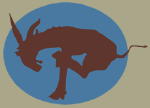Hobby Master HA7503 USAAC Boeing P-26A Peashooter Fighter - 95th Pursuit Squadron, March Field, California, 1935 (1:48 Scale)
"Why should we have a navy at all? There are no enemies for it to fight except apparently the Army Air Force."
- General Carl Spaatz, Commander of the US 8th Army Air Force, after WWII
 The American Boeing P-26, nicknamed the "Peashooter", was the first all-metal production fighter aircraft and the first pursuit monoplane used by the United States Army Air Corps. The prototype first flew in 1932, and were used by the Air Corps as late as 1941 in the Philippines.
The American Boeing P-26, nicknamed the "Peashooter", was the first all-metal production fighter aircraft and the first pursuit monoplane used by the United States Army Air Corps. The prototype first flew in 1932, and were used by the Air Corps as late as 1941 in the Philippines.
The Boeing-funded project to produce the Boeing Model 248 began in September 1931, with the Army Air Corps supplying engines and instruments. The design included an open cockpit, fixed landing gear and externally braced wings, the last such design procured by the USAAC as a fighter plane. It also saw the introduction of flaps to reduce speeds for landings. The Army Air Corps contracted for three prototypes, designated XP-936, with the first flight on March 20th, 1932.
The Boeing XP-936 had a landing problem. Sometimes when landing it would flip forward and because of the short nose it would roll onto its back. This injured many pilots until the unarmored back canopy was replaced with an armored headrest. An additional 25 aircraft were completed as P-26Bs, with Pratt & Whitney R-1340-33 Wasp engines, and 23 P-26Cs had minor changes to carburation and the fuel system. Both Spain (one fighter) and China (11 fighters) ordered the Model 281 export version of the P-26C in 1936.
The diminutive "Peashooter" as it became affectionately known by service pilots, was faster than previous American combat aircraft, but it was also an anachronism. Although the P-26 introduced a modern monoplane design, worldwide fighter aircraft developments soon outstripped the P-26. In Europe the Messerschmitt Bf 109 and Hawker Hurricane with closed cockpits and which both flew for the first time in 1935 were more representative of contemporary monoplane fighter designs. However, the P-26 was easy to fly and remained in active service for many years until the United States entered World War II.
Pictured here is a 1:48 scale replica of a Boeing P-26A Peashooter fighter that served with the 95th Pursuit Squadron, then operating out of March Field, California, during 1935.
Sold Out!
Dimensions:
Wingspan: 8-inches
Length: 5-3/4-inches
Release Date: November 2009
 Historical Account: "The Kicking Mule" - On August 20th, 1917, the 95th Aero Squadron was formed at Kelly Field Texas. In 1927, the Squadron was inactivated at March Field, California. Only 10 months later the Squadron was re-activated as the 95th Pursuit Squadron and retained the “Kicking Mule” insignia used since 1917. After several moves the 19th found itself at March Field, California, on August 9th, 1932, for the next six years as part of the 17th Pursuit Group. The 95th flew the P-26 in 1934 and 1935 when it was replaced by the Northrop A-17.
Historical Account: "The Kicking Mule" - On August 20th, 1917, the 95th Aero Squadron was formed at Kelly Field Texas. In 1927, the Squadron was inactivated at March Field, California. Only 10 months later the Squadron was re-activated as the 95th Pursuit Squadron and retained the “Kicking Mule” insignia used since 1917. After several moves the 19th found itself at March Field, California, on August 9th, 1932, for the next six years as part of the 17th Pursuit Group. The 95th flew the P-26 in 1934 and 1935 when it was replaced by the Northrop A-17.


